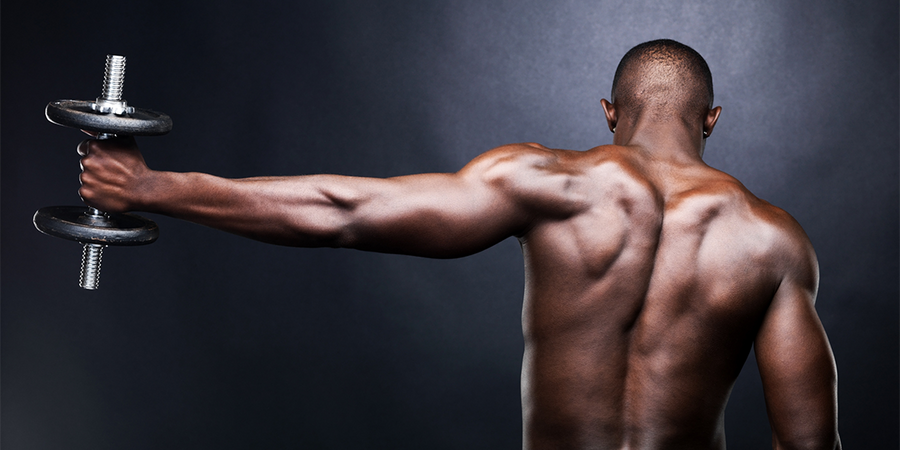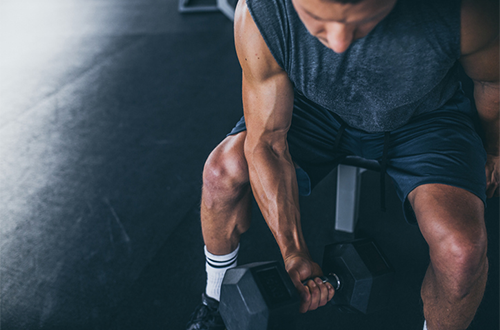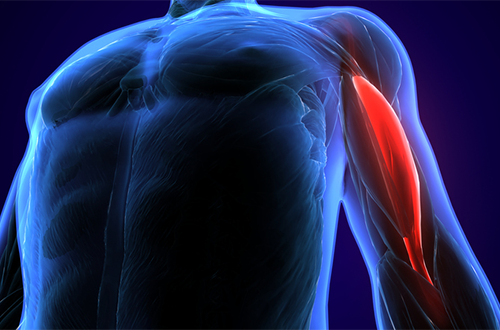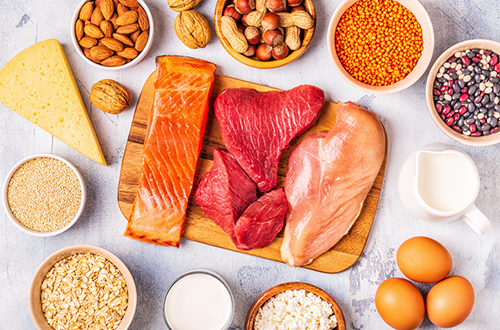
Hypertrophy: What It Is and How to Maximize It
By Andrew Heffernan
Getting jacked... Bulking up... Becoming swole...
Amidst gym-bro phrases like these, the sciencey term “hypertrophy" (pronounced hi-PURR-truh-fee) might sound out of place — but it's really just another word for the same thing: muscle growth.
Since the days when wrestler Milo of Croton trained for the 540 BC Olympics by hoisting a maturing calf on his shoulders each day, we've understood that muscles respond to lifting more weight gradually over time (a training technique called "progressive overload"). But beyond that, the science of muscle building is constantly evolving.
So, how does hypertrophy occur? And what's the best way to achieve it? Read on.
Support muscle repair and growth with the high-quality protein in LADDER Whey and Plant Protein.
.
What Is Hypertrophy?

Short answer: Hypertrophy is muscle growth. Lift progressively heavier weights, and over time your body builds more muscle and learns to engage it more efficiently, which helps you become stronger.
Your body is an adaptation machine: Feed it a stimulus on a regular basis and it transforms to accommodate that stimulus. Run long distances several days a week and your heart learns to pump oxygenated blood more efficiently so you can run further and faster before tiring.
But here's what many people forget (or never realize): When it comes to maximizing muscle growth (or any other training adaptation for that matter), what you do between workouts is just as important as what you do during them.
“Muscles don't grow during training sessions," says LADDER's Senior Director of Fitness and Nutrition Content Trevor Thieme, CSCS. “They grow between them, so you have to prioritize recovery as much as you do working out."
In practice, that means focusing on nutrition, performing activities that promote recovery (like dynamic stretching and foam rolling), and allowing sufficient time between workouts for your muscles to repair themselves and grow stronger. If you don't, you risk sabotaging both muscle growth and workout performance. Thieme's advice: Give yourself at least 48 hours between hard workouts that specifically target the same muscle group (e.g., don't do two "leg days" back-to-back). And schedule at least one recovery (i.e., non-workout) day per week.
.
The 3 Factors Affecting Hypertrophy
In 2010, fitness expert Brad Schoenfeld, Ph.D, C.S.C.S., C.S.P.S., F.N.S.C.A., enumerated three major factors — or pathways — that lead to muscle growth.
1. Mechanical tension

This term describes tightness in a muscle caused by contraction. You can feel it when you “make a muscle" with your biceps — a form of isometric (or static) contraction. You can also feel it when you do curls or presses, lifting and lowering a weight through a full range of motion with the muscle "tense" the whole time. For maximum hypertrophy, the second option (i.e., repeatedly contracting and extending a muscle under tension rather than contracting it isometrically) — is best.
In general, the greater a muscle's "time under tension" is, the greater its growth stimulus will be. The easiest ways to increase it? Grab a heavier weight and/or slow the pace of each rep.
2. Muscle damage

It may sound traumatic, but this refers to small tears in muscle fibers that are a natural consequence of strength training. Whenever you add a set or two to a workout program, perform a new exercise, lift a heavier weight, or emphasize the lowering (eccentric) phase of a movement (e.g., by slowing it down), you cause "micro trauma" or "micro damage" to your muscles, inducing them to repair themselves and grow bigger and stronger, so that they're better able to handle that stress the next time they encounter it.
Muscle damage is sometimes accompanied by delayed-onset muscle soreness (DOMS) — a deep muscle ache that peaks 24 to 48 hours after a tough workout. But don't be fooled: DOMS doesn't necessarily mean your muscles are growing.
“Soreness is actually a poor indicator of workout quality or effectiveness," says Thieme, adding that it usually just means that you switched up your routine or pushed yourself too hard. “In fact, if that soreness is severe enough to inhibit workout performance, it can actually sabotage muscle growth." So don't chase or celebrate soreness. "Try to avoid it by progressing gradually and keeping your nutrition on point," he says.
3. Metabolic stress

This is the burning sensation you feel when you work a muscle for all it's worth, usually with relatively light weights (60 percent of your one-rep max), relatively high reps (10 or more), and a relatively fast pace. That approach can trap blood in the muscles, prevent oxygen-rich blood from reaching them, and inhibit the removal of metabolic by-products, such as hydrogen ions.
All three of these factors (mechanical tension, muscle damage, and metabolic stress) are interrelated. Curl a challenging weight for five sets of 12 reps and you'll generate lots of tension, bring about metabolic stress, and — depending on how often you've done curls of late — likely cause some muscle damage as well.
You can also hone in on a single pathway. Curling a very heavy weight for three sets of three reps will generate a high levels of tension but only mild amounts of metabolic stress, whereas curling a much lighter weight at a faster pace will cause metabolic stress, but only low levels of tension.
.
Muscle Fiber Types and How to Develop Them
If you're a fitness buff, you may already know that there are two primary types of muscle fibers. Type I (a.k.a. slow-twitch) muscle fibers are recruited primarily during longer-duration, steady-state activities like jogging and cycling. In the gym, they're the ones that power you through lighter sets of 12 or more reps.
Type II (a.k.a. fast-twitch) muscle fibers help with higher-intensity, shorter-duration activities like sprinting and pumping iron. In the gym, they do the lion's share of the work when you lift a weight explosively, or for heavier sets of 10 or fewer reps.
Since all muscles contain both type I and type II fibers, and both fibers have the potential for hypertrophy (albeit, it's advisable to perform a variety of rep ranges for maximal muscle growth):
- Lower reps using heavier weights for maximal stimulation of type II fibers — and tension on the muscles.
- Higher reps using lighter weights for stimulation of type I fibers — and metabolic stress.
Sarcoplasma, myofibrils, and hypertrophy
Poke around the internet and you might see the word hypertrophy with the modifiers “myofibrillar" or “sarcoplasmic" shoehorned in front of it. These two terms refer to microscopic components of a muscle fiber/cell: the myofibril (the elongated threads that shorten when contracted), and the sarcoplasm (the surrounding fluid that nourishes and lubricates those threads).
Some fitness pros theorize that training with heavier weights causes the myofibrils to grow (hence, “myofibrillar hypertrophy") and lifting lighter weights causes the fluid around the fibers to increase (thus, “sarcoplasmic hypertrophy"). But so far, there's no science to support the theory that the two are caused by different types of lifting. Even if that turns out to be true, it doesn't alter the basic principle: for maximum hypertrophy, spend some time lifting heavier weights and some time lifting lighter ones.
.
How to Maximize Hypertrophy through Training

The burning question: What workout program yields the levels of tension, stress, and damage necessary to optimize hypertrophy — without causing injury?
The answer is that no one program is perfect for everyone. Every body is different, but we can extrapolate a handful of general guidelines on how best to build muscle mass based on current research.
1. Emphasize compound (multi-joint) exercises
The more muscle you work, the more muscle you build. It's that simple, which is why big, compound (multi joint/muscle) exercises like the deadlift, squat, pull-up, and chest press typically provide the most bang for your muscle building buck.
2. Regularly vary your routine
If you don't vary your workouts every few months, your muscles will become accustomed to them and will stop adapting (adaptation equals muscle growth). To prevent that from happening — and to optimize the "micro-damage" that that stimulates muscle growth — you have to regularly switch up your "training stimulus" by changing the exercises you do or how you perform them.
The latter can include altering your grip, shortening the rest periods between sets, changing your lifting tempo (e.g., by emphasizing the lowering phase of a lift), or trying new exercise variations.
3. Go heavy and light
You need to lift heavy to maximize muscular tension. But you should also do low weight/high rep sets to maximize metabolic stress. The latter kind of lifting will also target your type I muscle fibers, which studies show also have growth potential (although to a lesser degree than type II fibers).
4. Find your rep/set sweet spot
For most exercises in most workouts, perform 3 to 4 sets of 6 to 12 reps (or about 20 to 40 total reps), using a weight that makes the last 1 to 2 reps challenging.
.
How to Maximize Hypertrophy Between Workouts

So: Hit the gym several times a week, use a variety of exercises in a variety of rep ranges, don't slack off, and you'll look like Dwayne Johnson in a month, right?
Not quite. Muscle growth takes time, and not everyone is born with bodybuilder DNA. But following the tips above will help you maximize your genetic potential.
Besides your gym workouts, two of the most important factors for muscle growth are getting enough sleep (at least seven hours per night) and making some strategic tweaks to your diet. Priority number one: "Eat more protein," says Thieme.
Remember, muscles don't grow during workouts, but between them. What you do outside of the gym to support recovery and growth is, therefore, just as important as what you do inside it.
How much protein do I need to build muscle?
For a ballpark estimate of your daily needs, multiply your weight in pounds by .7: that's the number of grams of protein you need daily, off days and on, 365 days a year, as long as you're trying to optimize muscle mass.
Reality check: for a 135-pound woman, that comes to about 100 grams of protein a day; for a 185-pound man, it's almost 130. Most people who aren't die-hard carnivores have to get creative to hit those numbers, using high-quality protein shakes — like LADDER Whey and Plant Protein — and protein-rich snacks like cottage cheese and hard-boiled eggs throughout the day.
If you're interested in losing fat as well as gaining muscle, you can also drop your daily calorie intake slightly (e.g., by 200 to 300). Most, if not all, of those calories can come from carbs, but don't cut carbs too drastically, advises Thieme. “You need them to fuel your workouts."
Don't forget vitamin Z
Sleep is one of the most overlooked factors in muscle growth. Most people skimp on it regularly. But if you're serious about building muscle, seven to nine hours a night is essential. As much as possible, make those hours non-negotiable, and stick to a daily sleep schedule, even on weekends.
.
How Long Does It Take to Build Muscle?

How much muscle you build and how quickly you build it depends on a number of factors, including:
- Your age (younger people build muscle faster than older people)
- Your gender (men tend to muscle up faster than women), your hormone profile (individuals with higher levels of testosterone have an easier time building muscle)
- Your skeletal structure (thicker bones support thicker muscles).
Beyond that, there's the question of your unique genetic “stew." Some people simply have more type II fibers and/or build muscle faster than others. As with so much else in life, those are the breaks. But if you're just starting out, you'll likely notice increases in muscle size and definition after about four to six weeks, although you'll probably see strength increases much sooner thanks to faster adaptations in your nervous system, which activates your muscles.
Once muscle growth starts, it can progress fairly rapidly. "I've seen up to 10-pound gains in fat-free mass over three months," says Schoenfeld. That said, he's also seen others gain very little, owing to the genetic and lifestyle variables mentioned above.
"But if you want to average, that would be around five to six pounds over the three-month period." That eventually tapers off, of course, which is why Akira remains fiction. Schoenfeld puts it succinctly: "For those with lifting experience, the capacity to gain is substantially reduced."



